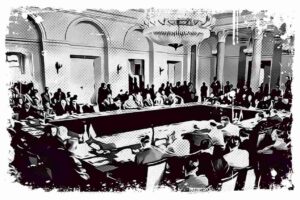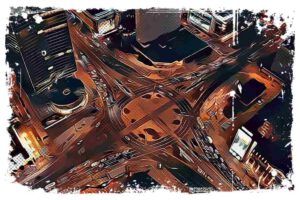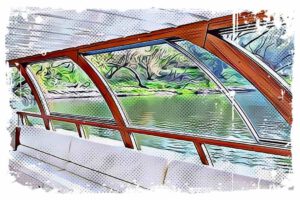It has been on the UNESCO World Heritage List since 1980 and, as stated in its justification, it is an exceptional example of the reconstruction of monuments that were almost completely destroyed. In 1944, 85% of the Old Town buildings were in ruins during the Warsaw Uprising. Since then, the medieval road system, historical buildings, mostly from the 17th and 18th centuries, and fortification walls from the 13th and 16th centuries have been rebuilt.

The most famous building in the Old Town is the Royal Palace which was originally Gothic but later rebuilt in Renaissance, early Baroque and Rococo styles. Warsaw was the seat of Polish kings after the capital was moved from Krakow.
If you visit the palace today, you can admire many historical rooms, works of art by Rembrandt and the royal insignia of Stanislaw August Poniatowski, the President of the Republic of Poland. You’ll also find the urn containing the heart of Tadeusz Kosciuszko. In front of the palace, on the Castle Square, there used to be the Sigismund Column from 1643-44, dedicated to King Sigismund III Vasa. It was the oldest secular monument in the capital and depicted the king on a 22-meter column.
The Old Town is also home to St. John’s Cathedral, built at the turn of the 13th and 14th centuries. Henryk Sienkiewicz, winner of the Nobel Prize for Literature, and Gabriel Narutowicz, the first president of the Second Republic, are buried here. The coronations of Stanislaw Leszczynski and Stanislaw August Poniatowski also took place in the palace.
↳ PRO TIP: Do you like traveling? Then before you buy any ticket or book an attraction, check if it's available in this worldwide Viator Database. You may save a lot of money and time. No need to thank me :)
The Old Town of Warsaw has two rows of fortifications. The Barbican, which was added to the defenses in 1548, is the most recognizable feature. It has a Renaissance-style attic on top. There is also a statue of a mermaid on the Old Town Square.
Amazing Stories About Old Town
It’s hard to believe that in the 13th and 14th centuries, the same street we use today for leisure activities was the center of the city. Back then, the Market Square was the epicenter of the city and Warsaw’s life was concentrated here.
The square has witnessed many important historical events, cultural gatherings, manifestos, and sadly, even public executions – all while still fulfilling its commercial purpose. It’s amazing how little the market’s role has changed over the years, except for the executions.
It is fascinating that the first houses in Warsaw were not brick, but wooden. Initially, the market was made up of stalls and stands, and you could see the whole market from wherever you turned.
At the beginning of the 15th century, the market was upgraded with a magnificent brick town hall. It was surrounded by stalls. On the northern side, there was a pillory and a cage used to expose those found to be guilty. It was around this time that the market was further enhanced with brick townhouses.
Fire In The City
Unfortunately, 1607 was an important year. Twenty-two houses in the Market Square were destroyed by a great fire. This had a significant impact on the architecture of the capital. This event marked the end of Gothic in Warsaw and caused the surrounding area to change.
The newly built houses were now three storeys high and designed to meet the modern economic needs. The appearance of the Market Square also changed as plaster was used instead of red bricks.
A Pillory in Warsaw’s Market Square
By order of the city, a pillory and a cage were built on the square. Criminals such as thieves, swindlers and prostitutes were kept there. This was also the place where death sentences were carried out by beheading, as was the case with the nobleman Jordanowski, who was responsible for the poisoning of the Mazovian princes in 1526.
Almost a century later, Piekarski was tortured for attempting to assassinate Sigismund III, and even later, a great champion of fighting the darkness and hypocrisy of the clergy was beheaded here.
Besides taking human lives, it was a place where books were destroyed. During the seventeenth and eighteenth centuries, books with heretical contents, political pamphlets, and poetic letters were burnt. Today, the pillory on the Market Square does not exist any more.
Tenement Houses in the Market Without an Address
In the past, tenements in Warsaw’s Old Town Square didn’t have specific house numbers like we do today. Can you imagine how confusing it would be for a postman or even a pizza delivery man to find you? Instead, these houses were identified by names derived from their owners’ crests, coats of arms, physical appearance, or last names. But now it’s hard to imagine a building without a number.
Little „Houses” on Top Of The Buildings
As you walk around the Market Square, you may have noticed little „houses” attached to the tops of some of the tenement buildings. People have come up with all sorts of legends and myths about what they were used for – some say they were nurseries, others thought they housed the studios of famous artists, and there were even rumors of princesses having lived in them. But the truth is far from these fanciful stories. These small structures were actually built to light the stairways inside the buildings, and are known as „lanterns”.
So why did they put lanterns on the tenements? It’s because the tenements of that time were designed in a unique way. They looked narrow from the outside, but inside they were long and had three rooms arranged in a row. As you can imagine, the first and third rooms were well-lit thanks to windows on the outside walls. The middle room, where the stairs were, had no natural light. In order to add a little bit of lighting to the staircase, they came up with the idea of lanterns. These small constructions solved the problem of the dark and gloomy staircase.
Attractions of the Old Market Square in Warsaw
The Market Square is home to two must-visit museums: The Museum of Warsaw, with collections illustrating the city’s rich history, and the Museum of Literature, a bibliophile’s paradise with a wealth of manuscripts, works of art, books, photographic documentation, and more. You can also get to know the Old Town by walking along the Cultural Wine Cellar Route.
Here are 10 highlights to consider if you’re planning a trip to the Warsaw’s Market Square:
W-Z Route
If you take a trip to the Old Town of Warsaw, don’t miss the W-Z Route (Wschód–Zachód which means East-West Route) at the foot of the Royal Castle. The W-Z Route (also known informally as the Wuzetka) is a major transport artery stretching 6,760 meters across the districts of Wola, Śródmieście, and Praga Północ. It forms part of provincial road No. 629, and is commonly referred to as the „Solidarność” Avenue.
It was built after the war and has many attractions to see. The moving staircase between the W-Z Route and the Castle Square, which was built immediately after the war, is the most notable.It stands out for its socialist-realist decoration and special post-war atmosphere. It is the first of its kind in Poland.
- Pictures and Google Maps Location: Here
Jesuit Church
The Jesuit Church is a landmark in the Old Town skyline. It has a soaring Renaissance steeple. Its history dates back to the 17th century. It is closely associated with the Jesuits and Father Peter Skarga. It was built between 1609 and 1626. It is a must-see religious monument in Warsaw. Be sure to stop and admire the beautiful painting of Our Lady of Grace – the patron saint of Warsaw – during your tour of the city.
- Pictures and Google Maps Location: Here
The Tenement House at Saint Anne’s
This is one of the most beautiful tenements in the Old Town, and it adds a beautiful touch to the Warsaw Market Square. Its name refers to the 16th-century statue of St. Anne Samotreti, and the building itself is one of the most interesting examples of late Renaissance architecture in the Polish capital.
- Pictures and Google Maps Location: Here
Historical Museum of the Capital City of Warsaw
The Historical Museum of the Capital City of Warsaw is one of the most important museums in the Polish capital. This museum is a must if you’re an architecture buff who wants to get up close and personal with interesting exhibits and the interiors of the most beautiful tenements in the Old Town. There’s a wealth of things to see and do here, from stunning interiors to artifacts from archaeological sites to photographs and paintings of old Warsaw.
- Pictures and Google Maps Location: Here
Nowomiejska Street
This is one of the most popular and exciting streets in Warsaw. It connects the Old Town Square with the New Town Gate and still has some interesting buildings. One of them is the house of the former president of Warsaw, Jan Dekert, who was also a resourceful leader and organizer of the Black Procession in December 1789. Also worth a look are the tenements on Figure and Paulinskaya streets.
- Pictures and Google Maps Location: Here
Mermaid Monument
This is one of Warsaw’s must-see attractions and should be included in any tour of the Old Town. The statue of the mermaid first appeared in the Old Town Square in the mid-19th century. Since 1928, it has been moved to various locations around the city and has adorned the walls of the capital. It returned to its original location in 1999 and quickly became one of the highlights of a visit to the Polish capital.
- Pictures and Google Maps Location: Here
St. John’s Cathedral
St. John’s Cathedral is a remarkable structure, especially for those who appreciate sacred architecture. It was first built in the 13th century and has been through a period of expansion and restoration to its former glory since the Second World War. The interior is filled with incredible pieces, such as the 16th century baptismal font, stunning stalls, and the tomb of the Mazovian princes. All of these are well worth a visit. The Baryczka Chapel is particularly impressive. It contains the Black Crucifix. It is one of the few parts of the cathedral that survived the war. It was brought here by Jurgo Baryczka, a merchant, who saved it from the hands of the reformers.
- Pictures and Google Maps Location: Here
Sigismund’s Column
The monument is remarkable for several reasons. In the first place, it is the first secular monument to be erected in Poland. Secondly, it serves as a valuable reminder of the era of King Wladyslaw IV, who decided to honor his father, Sigismund III Vasa, by having it built. The monument features a 3-meter tall figure of King Sigismund holding a cross and a saber on a high pedestal, and is 30 meters high.
- Pictures and Google Maps Location: Here
City Walls
In the early 1300s, Warsaw’s Old Town was protected by mud walls. These were replaced by brick walls and towers designed by John Baptist of Venice in the 1600s. This architect was also responsible for building the Barbican, which, along with the nearby Baths Gate and Powder Tower, formed the Zakroczym Gate. This fortification continues to amaze the tourists who pass through it on their way between the Old Town and the New Town.
- Pictures and Google Maps Location: Here
Royal Castle
The Warsaw Royal Castle is an iconic landmark in Poland and has been under reconstruction from 1971 to 1984. It is a must-see for visitors to the capital and is home to the Museum of the Residence of the Kings of the First Republic, with a stunning array of artifacts. Inside, you’ll find impressive interiors and parliamentary chambers, as well as spectacular works of art. Its gardens are perfect for a leisurely stroll and offer a peaceful respite in the heart of the city.
- Pictures and Google Maps Location: Here
Conclusion
The Old Town, with its charming streets, beautiful buildings and rich history, is a must for anyone visiting Warsaw. Staying in this area allows you to fully immerse yourself in its atmosphere and take your time to explore all its attractions. With a well-developed accommodation and transportation system, visitors can easily access different parts of the city, making it a convenient and enjoyable place to stay.
Bibliography
- https://muzeumwarszawy.pl/en/
- https://pl.wikipedia.org/wiki/Kamienica_pod_%C5%9Bw._Ann%C4%85_w_Warszawie
- https://en.wikipedia.org/wiki/Warsaw_Old_Town
- https://en.wikivoyage.org/wiki/Warsaw/Old_and_New_Town



